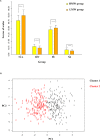Thought Control Ability Moderates the Effect of Mind Wandering on Positive Affect via the Frontoparietal Control Network
- PMID: 30740082
- PMCID: PMC6357679
- DOI: 10.3389/fpsyg.2018.02791
Thought Control Ability Moderates the Effect of Mind Wandering on Positive Affect via the Frontoparietal Control Network
Abstract
Mind wandering is a phenomenon that involves thoughts shifting away from a primary task to the process of dealing with other personal goals. A large number of studies have found that mind wandering can predict negative emotions, but researchers have seldom focused on the positive role of mind wandering. The current study aimed to explore the relationships among mind wandering, emotions and thought control ability, which is the ability to inhibit one's own unpleasant or unwanted intrusive thoughts. Here, we collected resting-state functional magnetic resonance imaging (rsfMRI) data from 368 participants who completed a set of questionnaires involving mind wandering, thought control ability and positive or negative emotions. The results revealed that (1) rsfMRI connectivity features related to thought control ability and mind wandering could divide individuals into two groups: HMW (high mind-wandering) group and LMW (low mind-wandering) group. The HMW group scored lower in thought control ability (TCA), higher in negative emotion (NE) and lower in positive emotion (PE) than the LMW group. (2) TCA moderated the association between MW and positive affect (PA). (3) Two groups exhibited different segregation within key nodes (SWKN) of the frontoparietal control network (FPCN), and the subsequent analysis showed that the SWKN of the FPCN was negatively correlated with PA. These findings indicate that TCA moderates the effect of mind wandering on affect via the FPCN, which may have important implications for our understanding of the positive role of mind wandering.
Keywords: frontoparietal control network; mind wandering; moderating effect; positive affect; thought control ability.
Figures




Similar articles
-
Tracking resting-state functional connectivity changes and mind wandering: A longitudinal neuroimaging study.Neuropsychologia. 2021 Jan 8;150:107674. doi: 10.1016/j.neuropsychologia.2020.107674. Epub 2020 Nov 10. Neuropsychologia. 2021. PMID: 33186573
-
Functional connectivity within and between intrinsic brain networks correlates with trait mind wandering.Neuropsychologia. 2017 Aug;103:140-153. doi: 10.1016/j.neuropsychologia.2017.07.006. Epub 2017 Jul 10. Neuropsychologia. 2017. PMID: 28705691
-
Pleasantness of mind wandering is positively associated with focus back effort in daily life: Evidence from resting state fMRI.Brain Cogn. 2021 Jun;150:105731. doi: 10.1016/j.bandc.2021.105731. Epub 2021 Apr 15. Brain Cogn. 2021. PMID: 33866054
-
Mind-wandering: mechanistic insights from lesion, tDCS, and iEEG.Trends Cogn Sci. 2022 Mar;26(3):268-282. doi: 10.1016/j.tics.2021.12.005. Epub 2022 Jan 24. Trends Cogn Sci. 2022. PMID: 35086725 Free PMC article. Review.
-
Mind-wandering, cognition, and performance: a theory-driven meta-analysis of attention regulation.Psychol Bull. 2014 Nov;140(6):1411-1431. doi: 10.1037/a0037428. Epub 2014 Aug 4. Psychol Bull. 2014. PMID: 25089941 Review.
Cited by
-
Perceived Self-Control Effort, Subjective Vitality, and General Affect in an Associative Structure.Front Psychol. 2021 Apr 14;12:575357. doi: 10.3389/fpsyg.2021.575357. eCollection 2021. Front Psychol. 2021. PMID: 33935847 Free PMC article.
References
LinkOut - more resources
Full Text Sources

